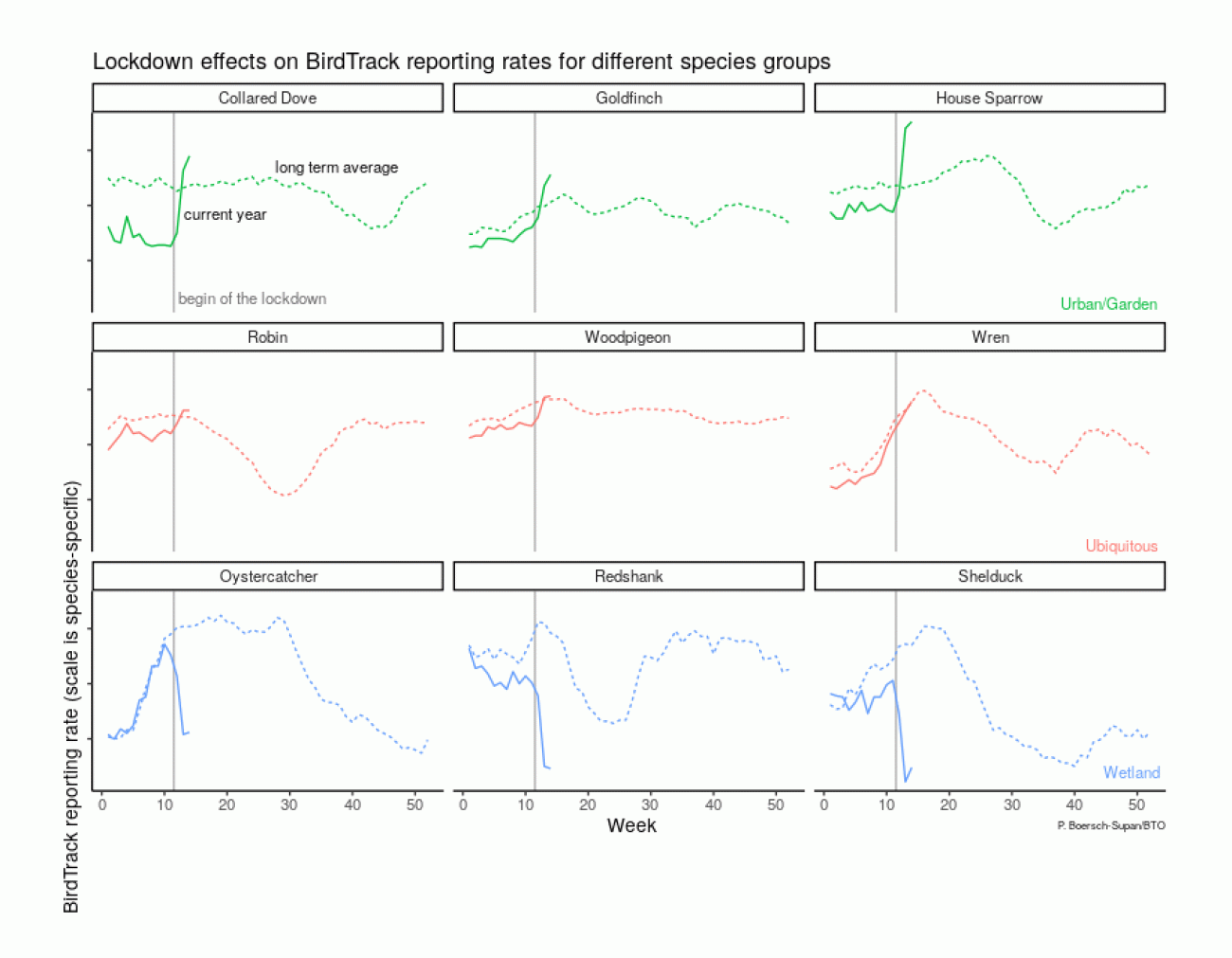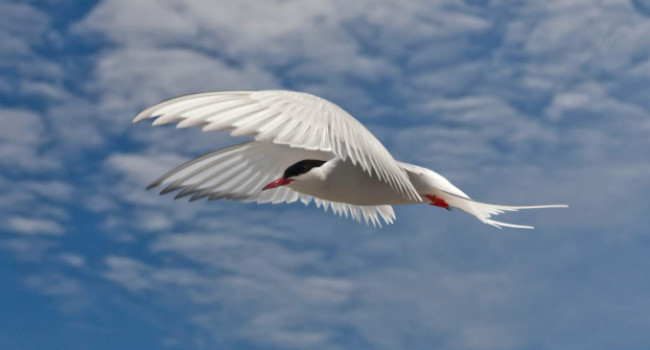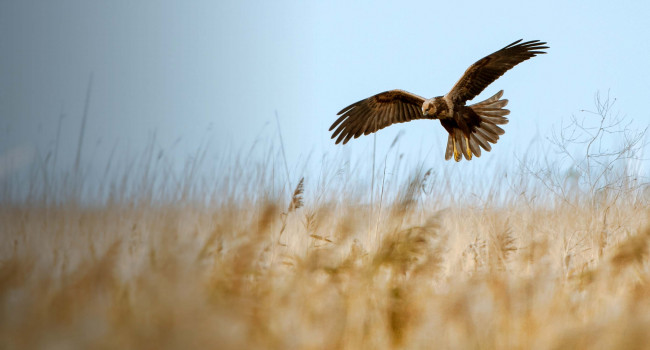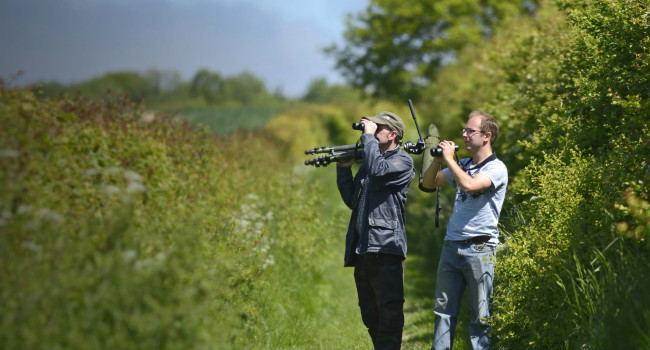
BirdTrack — a Swiss army knife in BTO’s toolkit?
BTO’s Ecological Statistician Philipp Boersch-Supan explains the insights BirdTrack records can provide.
Philipp leads a team of statisticians and quantitive ecologists who champion a culture of thoughtful and robust data analysis at the BTO and in the wider conservation science community. He oversees the development and implementation of new statistical techniques and leads a programme of statistical research, covering topics such as the design of biodiversity surveys, analyses of large-scale and long-term datasets and the evaluation of monitoring technology.
Relates to projects
Related Publications
Impressive as it is, the number of BBS visits is dwarfed by almost 80,000 complete lists collected by BirdTrack participants at over 16,000 locations during the same breeding season. Unlike BBS, however, BirdTrack in its current form is not a systematic monitoring scheme. It grew out of MigrationWatch, a survey aimed at recording the arrival patterns of migrant birds to Britain and Ireland, into – as BTO CEO Andy Clements recently put it – a personal online notebook for all birding activity. BirdTrack participants are free to go birding when and where they choose. They can count the birds they see, or just note species’ presences; they can record complete lists of all the birds they observe, or just record casual observations that they find interesting. This flexibility is an important feature of BirdTrack as a general purpose tool for bird recording, and to enable birders at all skill levels to participate. However, it leads to a data set that is not only very large, but also unstructured.
... watching and recording birds should be equally rewarding during a full on birding excursion as when walking your dog or sitting in your garden on a weekend afternoon.

For an analyst like me, the bounty of records from BirdTrack is incredibly attractive. A platform that delivers millions of records every year raises the promise of ever richer information about the state of our birds. However, extracting these riches is not an easy undertaking. Not only is BirdTrack creating a larger dataset than any other BTO scheme, but the unstructured nature of the BirdTrack records also makes them particularly tricky to analyse. BirdTrack participants may go to sites that are easy to access or rich in birdlife. Some sites will be visited very often, like popular nature reserves or someone’s local patch, but for many sites revisits are scarce. Skill levels vary between observers, and observer effort varies from visit to visit; sometimes they record everything, other times just one or two notable species. Allowing this variability in the observation process is a key feature of BirdTrack: watching and recording birds should be equally rewarding during a full on birding excursion as when walking your dog or sitting in your garden on a weekend afternoon. However, it does make it much harder to understand whether or not we can draw general conclusions about bird population from BirdTrack data. To overcome this big data challenge we harnessed the power of the JASMIN supercomputer maintained by the Natural Environment Research Council. Its processing capacity made the wrangling of BirdTrack data a lot easier. Addressing the analytical challenges took a bit more thinking, but generous donations to the BirdTrack Research Appeal have enabled me and my colleagues to work towards a better understanding of the riches contained in BirdTrack data.
To start with, my predecessor, Alison Johnston, looked at whether there was a bias in the locations that BirdTrack users visited. She did this by testing whether BirdTrack data could be used to reproduce bird distributions as mapped in the Bird Atlas 2007‒11. The Bird Atlas, like BBS, was based on structured survey visits all across the country. Her work confirmed that BirdTrack participants do have preferred birdwatching spots. For example, BirdTrack users are more likely to record close to their homes, but they also travel further afield to reserves or sites where there are a lot of species of birds, or to find particularly rare birds. This preference for certain locations, however, could be largely accounted for by statistical analyses, allowing us to accurately map species’ distributions. The only place where BirdTrack data alone led to less accurate and less precise distribution maps than the Atlas data was the Scottish Highlands. This is the result of relatively few observations in this area, and the fact that the mountain environment is unlike anywhere else in the country, making the relationship between species distributions and the environment harder to predict.

We next examined year-on-year changes using BirdTrack data. We explored to what extent the trends of species reports in BirdTrack match the population trends we get every year from the BBS. We calculated reporting rate trends from complete BirdTrack lists using statistical models which accounted for differences in effort, such as the time spent compiling a BirdTrack list. We compared these trends to BBS trends, our gold standard for measuring bird population change over time. For 90 of the 141 species we investigated, year-on-year changes in BirdTrack reporting rates showed a close relationship to BBS trends. However, the trends were more similar for widespread species, such as Blue Tits, and for species whose populations are changing dramatically, like the rapidly declining Turtle Dove. So while the results did provide evidence that there is information about population changes in the BirdTrack data, the devil remains in the detail. We found less agreement between BirdTrack and BBS data for rarer species. This means BirdTrack data analysed with this approach do not provide a simple way to increase our knowledge about those species not monitored by BBS. Species that are currently colonizing the UK also stood out: “newcomers” like Ring-necked Parakeet and Little Egret were much more frequently reported in BirdTrack complete lists than we would expect from their BBS trends, suggesting that the novelty of seeing these species makes starting a list more likely.
All in all, we have learned that despite people choosing convenient or appealing birding sites and reporting some species more than others, there is a lot of valuable information about species trends and distributions contained in the ever growing BirdTrack data set. BirdTrack data on their own may come with limitations, but there is promise that combining structured BBS data and unstructured BirdTrack data can maximize the information available. This combined approach would leverage both the rigour of BBS and the Atlas, and the bounty of BirdTrack. From my perspective BirdTrack is the Swiss army knife in BTO’s toolkit: it might not be able to deliver the same precision as the dedicated tools that are provided by our structured surveys, but it is a great all-round tool to collect records around the year, wherever you are. We still have some way to go before we can routinely incorporate BirdTrack data into our trends and maps, but I for one am very excited about working with all of the tools on offer.
14/4/2020 - An update on the effects of the lockdown on reporting rates for different bird groups
As we head into the third week of staying at home you may have noticed that the reporting rate trends on the BirdTrack website are starting to look rather unusual this year. Since Mid-March there is a spike in reporting for House Sparrows, Oystercatcher reports are crashing, whilst for Wrens the reporting rate curve looks pretty normal. In fact, this pattern is repeated across many species and broadly speaking there are three groups: The perceived winners of the lockdown are birds which are common in human environments such as towns and gardens, the perceived losers are birds that are usually found further afield, particularly in wetlands and on the coast, and little change appears to have happened to a few species that are widespread and common across many habitat types.
Of course these graphs tell us much more about birder behaviour than about the birds themselves. House Sparrow populations are unlikely to have changed much between the start and end of March and Oystercatchers are probably doing just as fine now as they did a fortnight ago. What has changed, however, is the way we watch and record birds in these weeks. As we are confined to our flats and houses, birdwatching is limited to what we can see from our windows, in our gardens, or on our daily walks close to home. For most of us that doesn’t include wetland habitats or the seashore. This drastic change in where we can go birdwatching is the underlying cause of the unusual reporting rate graphs on birdtrack.net. They are simple summaries, calculated across all complete lists submitted in a given week.

The last two weeks everyone has been lockdown birding, while usually birdwatchers would be out and about at this time to track Spring migration. Given these unusual circumstances, the simple reporting rate graphs are therefore not useful this year to compare year-on-year changes in the timing of migration or relative abundance of any given species. While popular among birdwatchers for quick comparison, the simple reporting rate graphs were never intended to serve as a robust population assessment tool. BirdTrack observations have always come from a biased set of locations – the places that birders like to visit. Even before the current and extraordinary changes to birdwatching there have been subtle changes in where those places are. For example, visits to urban sites have increased steadily since the inception of the scheme. Such changes shift the composition of habitats represented in each year and make comparisons based on simple summaries increasingly difficult. But fear not, funded by the BirdTrack Appeal, we have spent considerable effort in recent years to develop methods that allow us to use BirdTrack data regardless of the changes in observer behaviour. Recent research by my predecessor, Alison Johnston, has demonstrated that we can statistically account for biases in BirdTrack data to obtain accurate information about bird distributions, and further work is underway by myself and my colleagues to extend these methods to look at temporal trends.
So while this year is unlike any other, do keep birding wherever you safely can – from your kitchen window or on your daily walk. Our data visualisations have yet to catch up with the circumstances, but rest assured: now as ever, any submitted list is valuable information.
Do you take part in BBS or use BirdTrack? What do you think the barriers and advantages are of both? Let us know what you think in the comments below.
Add scientific value to your BirdTrack lists
Any record is valuable and will be safely curated in the BirdTrack database, but these simple suggestions ensure your BirdTrack lists are fit for trend analyses:
- Anyone can collect a complete list, even if you are new to birding. Record all the species you confidently identified by sight or sound. If in doubt, leave it out - our analyses take account of the fact that in any given complete list, there are likely to be a few apparently “obvious” species missing.
- Provide start and end times and limit your list to a continuous period of active birding – this allows our analysts to quantify effort and to better estimate how detectable different species are. If you are out all day, start a new list for every bout of birding.
- Revisit your birding spots (not just your patch!) Any submitted list is valuable, but for trend analysis it is particularly important to have observations from sites that are revisited both within and among years.
Acknowledgements
This research was made possible by your generous donations to the BirdTrack Research Appeal and the thousands of volunteers participating in the Atlas, BBS, and BirdTrack.








Share this page